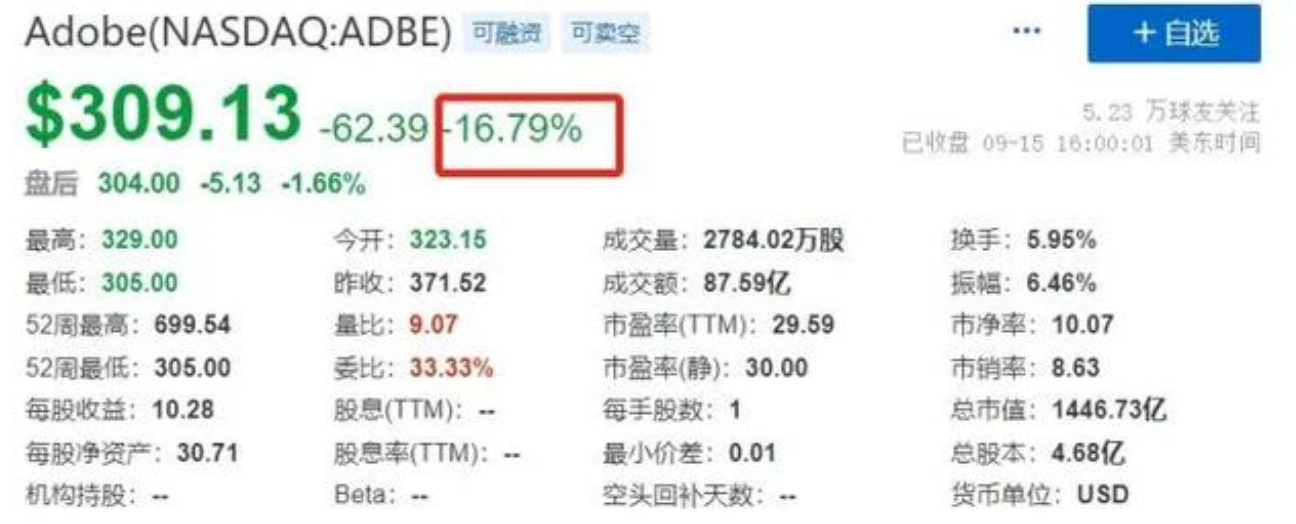Recently, a thunderous news has appeared in the software industry - the American design software giant Adobe has made a huge increase, throwing $20 billion to acquire the popular Web collaborative design tool Figma. But unfortunately, investors don't seem to be optimistic about this Adobe acquisition. Although from the perspective of the two companies alone, it is indeed a strong alliance. Figma is the fastest-growing online collaborative office design software in recent years. Its annual revenue reached about 75 million US dollars, and its revenue doubled to 150 million US dollars in the second year. According to Adobe's forecast for Figma, Figma's revenue this year may be around 400 million US dollars. From an investment point of view, Figma's results are completely unusual. With only $75 million in revenue in 2020, its valuation is close to $2 billion, and its market-to-sales ratio is close to 2,000%. In June 2021, when Figma received a new round of financing again, the revenue forecast by the media at that time was about 150 million US dollars, and its valuation was about to exceed 10 billion US dollars, which means that in just one year, Figma's valuation has reached a new high, almost 100 times its revenue. After the announcement of the news, Adobe's share price did not rise sharply after the opening of each share, but ushered in an unexpected plunge, with the highest drop yesterday even approaching 17%. And this 17% means that Adobe has evaporated nearly 30 billion US dollars in market value, and the total transaction amount this time is only 20 billion US dollars. In an inappropriate way, this almost means that Adobe has lost 1 day in the past. nearly $50 billion. |Why Adobe just can't let Figma go? Why can't Adobe, the industry leader, hold a small Figma? First, there is the potentially huge possibility. As mentioned above, the collaboration of the designer team is becoming more and more important. With the gradual development of e-commerce, more and more materials, designs, UI, etc. need to be developed through cross- departmental collaboration. Finish. Secondly, it is the development of the industry. In fact, many practitioners in the marketing industry have told Morketing when talking about this issue that at present, the development of Martech from the technical level has almost reached the ceiling, and there will not be too many changes. If you want to continue involution, there is almost only one way to price war. From the current point of view, the trend of the industry points to content technology. However, this point has also been mentioned above. Although this may be a new trend in future development at present, but at this stage, advertisers are not very accepting of this form of content in the middle stage, and paying Willingness can only be said in general. That means Figma still has a long way to go. Finally, Figma has really caused huge trouble for Adobe right now. In the five areas of UI design, prototyping, delivery, design system, and version control, it is the first; in the whiteboard area, the second and third are Figma; instead of continuing to let development, it is better to take it under its command. |Why is Figma valued? Figma adopts a two-pronged strategy: on the one hand, it converts paying users from the existing user pool and charges through value-added services and team products; on the other hand, the company has also established a professional toB sales team to find benchmark customers and work with them Polishing the product, the early big customers such as Airbnb, Dropbox, Microsoft, Uber, etc. came from this. According to public data, Figma’s revenue in 2020 has reached $75 million. This product foundation and business path planning has made Figma a SaaS star company. The company's current series of data performance is also quite eye-catching: ARR will reach US$400 million in 2022, a year-on-year increase of 100%; net revenue retention rate (NDR) exceeds 150%; gross profit exceeds 90%; operating cash flow is positive; 4 million users, of which more than 80% are users outside the United States. At present, from these data, whether in terms of financial performance or in terms of user volume, Figma's blessing is an even more powerful business for Adobe. After the acquisition, the two sides also have the opportunity to leverage each other's customer base to achieve the next step of growth. The Wall Street Journal reported that two-thirds of Figma's 4 million users are not Adobe's core designer customers. After the acquisition, Adobe Opportunities to sell to Figma's customers will be sought, and to Adobe Creative Cloud's existing 26 million customers, the company will also have the opportunity to sell Figma's products. This acquisition can be seen as a routine operation on Adobe's ecological road. Since 1990, Adobe has completed more than 50 acquisitions, and the well-known Photoshop was acquired in 1995. In the first half of this year, the company's market value reached $196.41 billion, surpassing Salesforce and becoming the world's most valuable SaaS company. The sharp drop in the stock price after the acquisition of Figma has caused its market value to fall to $140.166 billion, falling from the first throne. The impact of short-term market changes on this company and this transaction is not yet known, but for Adobe at this stage, it seems that there is no other choice for the next development except to continue to acquire and expand the ecosystem. The path that most SaaS giants choose to take.






